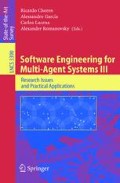Abstract
Multi-agent systems present a promising paradigm for coping with the complexity of intelligent mechatronic applications, particularly where purposeful behavior and complex structures emerge from the interactions of seemingly simple elements. The safety of mechatronic systems relies on predictability, which is apparently at odds with the concept of emergent behavior. When designing complex mechatronic multi-agent systems, the main challenge thus lies in achieving predictability without ruling out the desired emergent behavior. We propose to achieve this by decomposing the requirements and design into largely independent concerns, represented by social structures with behavioral norms, which are reconciled at the agent level. An explicit grounding of all constructs in observable entities from the mechatronic system’s environment model makes them amenable to formal analysis and enables rapid prototyping.
This work was developed in the course of the Special Research Initiative 614 – Self-optimizing Concepts and Structures in Mechanical Engineering – University of Paderborn, and was published on its behalf and funded by the Deutsche Forschungsgemeinschaft.
Access this chapter
Tax calculation will be finalised at checkout
Purchases are for personal use only
Preview
Unable to display preview. Download preview PDF.
References
Dawson, D., Seward, D.B., Burge, S.: Mechatronics and the Design of Intelligent Machines and Systems. Nelson Thornes (2000)
Kennedy, J., Eberhardt, R.C.: Swarm Intelligence. Morgan Kaufmann publishers Inc., San Mateo (2001)
Mullin, M.: Rapid prototyping for object oriented systems. Addison-Wesley, Reading (1990)
Brooks, R.A.: Intelligence Without Reason. In: Myopoulos, J., Reiter, R. (eds.) Proceedings of the 12th International Joint Conference on Artificial Intelligence (IJCAI 1991), Sydney, Australia, pp. 569–595. Morgan Kaufmann publishers Inc., San Mateo (1991)
Fischer, T., Niere, J., Torunski, L., Zündorf, A.: Story Diagrams: A new Graph Rewrite Language based on the Unified Modeling Language. In: Engels, G., Rozenberg, G. (eds.) TAGT 1998. LNCS, vol. 1764, pp. 296–309. Springer, Heidelberg (2000)
Rozenberg, G. (ed.): Handbook of Graph Grammars and Computing by Graph Transformation: Foundations, vol. 1. World Scientific Pub. Co., Singapore (1997)
Singh, M.P.: On Competitive On-Line Algorithms for the Dynamic Priority-Ordering Problem. IEEE Computer 31, 40–47 (1998)
Giese, H., Tichy, M., Burmester, S., Schäfer, W., Flake, S.: Towards the compositional verification of real-time uml designs. In: Proc. of the European Software Engineering Conference (ESEC). ACM Press, Helsinki (2003)
Giese, H., Vilbig, A.: Separation of Non-Orthogonal Concerns in Software Architecture and Design. Technical Report tr-ri-03-238, University of Paderborn, Paderborn, Germany (2003)
Giese, H., Burmester, S., Klein, F., Schilling, D., Tichy, M.: Multi-Agent System Design for Safety-Critical Self-Optimizing Mechatronic Systems with UML. In: OOPSLA 2003 - 2nd International Workshop on Agent-Oriented Methodologies, Anaheim, CA, USA (2003)
Giese, H., Vilbig, A.: Separation of Non-Orthogonal Concerns in Software Architecture and Design. Software and System Modeling (SoSyM) (2005) (accepted)
Varró, D.: Automated formal verification of visual modeling languages by model checking. Journal of Software and Systems Modelling (2003); Accepted to the Special Issue on Graph Transformation and Visual Modelling Techniques
Heckel, R., Küster, J., Taentzer, G.: Towards automatic translation of UML models into semantic domains. In: Proceedings of the Applied Graph Transformation (AGT 2002) Workshop, pp. 11–22 (2002)
Kóhler, H., Nickel, U., Niere, J., Zündorf, A.: Integrating UML Diagrams for Production Control Systems. In: Proc. of the 22nd International Conference on Software Engineering (ICSE), Limerick, Irland, pp. 241–251. ACM Press, New York (2000)
Dijkstra, E.W.: A Discipline of Programming. Prentice Hall, Englewood Cliffs (1976)
Kiczales, G., Lamping, J., Mendhekar, A., Maeda, C., Lopes, C.V., Loingtier, J.M., Irwin, J.: Aspect-Oriented Programming. In: Aksit, M., Matsuoka, S. (eds.) ECOOP 1997. LNCS, vol. 1241, pp. 220–242. Springer, Heidelberg (1997)
Harrison, W., Ossher, H.: Subject-oriented programming (a critique of pure objects). In: OOPSLA 1993. ACM SIGPLAN Notices, vol. 28, pp. 411–428 (1993)
Clarke, S., Harrison, W., Ossher, H., Tarr, P.: Subject-Oriented Design: Towards Improved Alignment of Requirements, Design and Code. In: Conference on Object-Oriented Programming, Systems, Languages, and Applications, Denver, Colerado, USA, November 1-5, pp. 325–339 (1999)
Reenskaug, T., Wold, P., Lehene, O.A.: Working with Objects: The OOram Software Engineering Method. Addison-Wesley/Manning (1996)
Mekerke, F., Georg, G., Franc, R.: Tool Support for Aspect-Oriented Design. In: Bruel, J.-M., Bellahsène, Z. (eds.) OOIS 2002. LNCS, vol. 2426, pp. 280–289. Springer, Heidelberg (2002)
Garcia, A., Silva, V., Chavez, C., Lucena, C.: Engineering multi-agent systems with aspects and patterns. J. Braz. Comp. Soc. 8, 57–72 (2002)
Ferber, J., Gutknecht, O., Michel, F.: From Agents to Organizations: An Organizational View ofMulti-agent Systems. In: Giorgini, P., Müller, J.P., Odell, J.J. (eds.) AOSE 2003. LNCS, vol. 2935, pp. 214–230. Springer, Heidelberg (2004)
Deppe, M., Robrecht, M., Zanella, M., Hardt, W.: Rapid prototyping of real-time control laws for complex mechatronic systems. In: Proc. of the 12th IEEE International Workshop on Rapid System Prototyping (RSP 2001), pp. 188–193. IEEE Computer Society, Monterey (2001)
Schupp, G., Jaschinksi, A.: Virtual prototyping: the future way of designing railway vehi-cles. International Journal of Vehicle Design 22, 93–115 (1999)
Beck, K.: Extreme Programming Explained: Embrace Change. Addison-Wesley Professional, Reading (1999)
Connell, J., Shafer, L.: Object-Oriented Rapid Prototyping. Yourdon Press, Englewood Cliffs (1995)
Popovici, A., Gross, T., Alonso, G.: Dynamic weaving for aspect-oriented programming. In: Proceedings of the 1st international conference on Aspect-oriented software development, pp. 141–147. ACM Press, New York (2002)
Author information
Authors and Affiliations
Editor information
Editors and Affiliations
Rights and permissions
Copyright information
© 2005 Springer-Verlag Berlin Heidelberg
About this paper
Cite this paper
Klein, F., Giese, H. (2005). Separation of Concerns for Mechatronic Multi-agent Systems Through Dynamic Communities. In: Choren, R., Garcia, A., Lucena, C., Romanovsky, A. (eds) Software Engineering for Multi-Agent Systems III. SELMAS 2004. Lecture Notes in Computer Science, vol 3390. Springer, Berlin, Heidelberg. https://doi.org/10.1007/978-3-540-31846-0_16
Download citation
DOI: https://doi.org/10.1007/978-3-540-31846-0_16
Publisher Name: Springer, Berlin, Heidelberg
Print ISBN: 978-3-540-24843-9
Online ISBN: 978-3-540-31846-0
eBook Packages: Computer ScienceComputer Science (R0)

